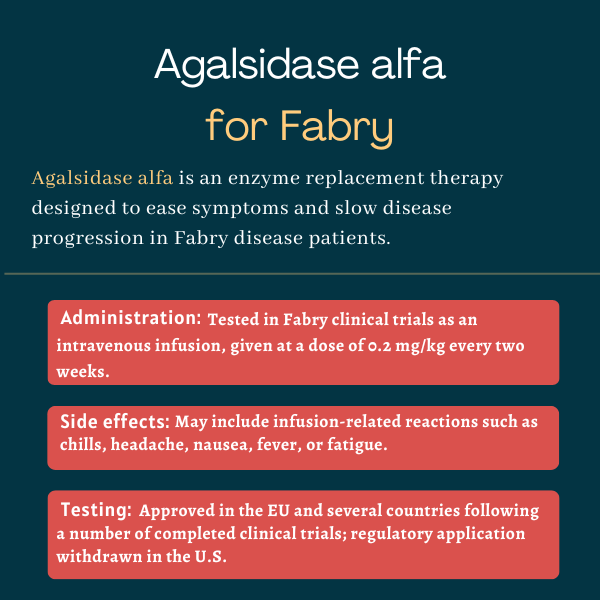
Agalsidase alfa for Fabry disease
Last updated March 12, 2024, by Lindsey Shapiro, PhD

What is agalsidase alfa for Fabry disease?
Agalsidase alfa is an enzyme replacement therapy (ERT) designed to provide a functional alpha-galactosidase A (Gal A) enzyme to people with Fabry disease, which is expected to ease symptoms and slow disease progression.
The therapy, developed by Shire (now owned by Takeda), has been approved in the European Union (EU) since 2001 and also is approved in many other countries worldwide. It is sold in these nations under the brand name Replagal.
While Shire also sought the approval of agalsidase alfa in the U.S., the company withdrew its marketing application in 2012 after it became clear that the U.S. Food and Drug Administration would require additional controlled clinical studies. No concerns over the therapy’s safety were raised by the agency.
Therapy snapshot
| Treatment name: | Agalsidase alfa |
| Administration: | Tested in Fabry disease as an intravenous infusion |
| Clinical testing: | Phase 3 trials completed; approved in several countries excluding the U.S. |
How does agalsidase alfa work?
Due to mutations in the GLA gene, Fabry disease patients lack functional alpha-galactosidase A enzyme, which is needed to break down certain fat molecules, namely globotriaosylceramide (Gb3). Without the Gal A enzyme, these molecules accumulate to toxic levels inside cells, causing damage to multiple tissues and organs, including the heart, kidneys, and nervous system.
Agalsidase alfa is a concentrated, lab-made form of Gal A designed to temporarily provide patients with the enzyme they need to break down Gb3 and other molecules, thereby easing Fabry symptoms and slowing organ damage. It is made by genetically engineering human cells in the lab to produce agalsidase alfa. The enzyme is then isolated from the cells and purified to make the medication.
How is agalsidase alfa administered in Fabry disease?
In Fabry clinical trials, agalsidase alfa was administered via intravenous (into-the-vein) infusions. The doses that ranged from 0.2 mg/kg of body weight every other week to 0.4 mg/kg weekly.
Because Shire withdrew its marketing application in the U.S. and other enzyme replacement therapies have been approved over the past decades, it’s unlikely the therapy will ever be approved for Fabry disease patients in the country.
In Europe, agalsidase alfa is administered via intravenous infusions once every other week at a dose of 0.2 mg/kg of body weight. Each infusion lasts about 40 minutes, and is typically performed by a healthcare provider, although self-administration at home may be considered for patients who are tolerating the medication well.
Agalsidase alfa in clinical trials
Agalsidase alfa’s safety and efficacy were first evaluated in two randomized, controlled clinical trials, and the therapy then was tested in patients who had not yet received any treatment for Fabry disease. Additionally, the ERT was assessed in children with Fabry in a pediatric study.
Early trials
In the first study, which enrolled 26 adult men with Fabry, six months of treatment with agalsidase alfa (0.2 mg/kg every other week) was associated with significant reductions in pain, and in pain medication use, relative to a placebo.
The treatment also improved or stabilized kidney function, compared with a decline in patients given the placebo, and further delayed progression to end-stage renal disease in people with more severe kidney problems. Long-term treatment for up to 4.5 years also was associated with cardiac and life quality improvements.
In a second study, agalsidase alfa was tested in 15 Fabry male adults with left ventricular hypertrophy, a cardiac condition in which the walls of the left ventricle — the heart’s main pumping chamber — are thickened and enlarged.
Use of the therapy was associated with decreases in left ventricular size, while placebo-treated patients conversely experienced an increase in size. Decreases in Gb3 accumulation across several organs also were observed with agalsidase alfa relative to the placebo. Additionally, reductions in blood Gb3 were maintained for at least two years in the trial’s open-label extension part.
Phase 3 trial in adults
An open-label Phase 3/4 trial (NCT00864851) evaluated the safety and effectiveness of several dosing regimens of agalsidase alfa on heart function among 44 treatment-naïve adults with Fabry who had signs of left ventricular hypertrophy. Participants were assigned to receive one of three different dosing regimens for a year: 0.2 mg/kg every other week, 0.2 mg/kg weekly, or 0.4 mg/kg weekly. There was no control group.
The trial’s results demonstrated that all doses were associated with stable heart muscle mass and cardiac function, as well as stable exercise tolerance and kidney function, without notable differences between the treatment groups.
After the main trial, participants were able to enter an open-label extension study (NCT01124643) in which all received agalsidase alfa at its standard dose of 0.2 mg/kg every other week for another year. Heart mass and cardiac function, as well as renal function and life quality, all remained stable throughout treatment, the results showed. Gb3 levels declined in the first months and stabilized thereafter.
Phase 2 trial in pediatric patients
A Phase 2 clinical trial (NCT00084084) evaluated the long-term safety and efficacy of agalsidase alfa in 17 children with Fabry disease, ages 7-17, who had rolled over from a previous six-month study. All received agalsidase alfa (0.2 mg/kg) every other week for up to 6.5 years.
Results spanning up to seven years of treatment across the two studies showed agalsidase alfa was generally well tolerated in these young patients. Kidney function and heart mass remained stable throughout the study. Improvements in heart rate and reductions in Gb3 achieved during the earlier trial generally were sustained.

Common side effects of agalsidase alfa
The most common side effects associated with the use of agalsidase alfa are infusion-related reactions, which may include chills, headache, nausea, fever, fatigue, vomiting, and difficulty breathing. Children and adolescents may be more likely than adults to experience such reactions.
Other side effects that also are common with agalsidase alfa include:
- swelling in the legs and arms
- tingling, numbness, or pain in the fingers or toes
- ear ringing (tinnitus)
- heart palpitations
- sore throat
- abdominal pain or diarrhea
- rash
- pain in the back, limbs, muscles, or joints
- chest pain
- cold-like symptoms.
Fabry Disease News is strictly a news and information website about the disease. It does not provide medical advice, diagnosis, or treatment. This content is not intended to be a substitute for professional medical advice, diagnosis, or treatment. Always seek the advice of your physician or other qualified health provider with any questions you may have regarding a medical condition. Never disregard professional medical advice or delay in seeking it because of something you have read on this website.
Recent Posts
- Canada approves ERT Elfabrio for adults with Fabry disease
- I work hard to influence my health outcome with Fabry disease
- Canadian study highlights stroke danger for young adults with Fabry
- Fabry treatment ST-920 boosts kidney, heart function in trial
- Echocardiograms may spot early heart disease in Fabry, study finds
- In rare case, woman diagnosed with both Fabry and blood disorder
- Companies challenge EMA advice rejecting monthly Elfabrio dosing
- ERT may protect heart function after Fabry kidney failure
- Helping my children with Fabry find ways to combat depression
- EU agency urges against monthly dosing plan for Fabry drug Elfabrio




